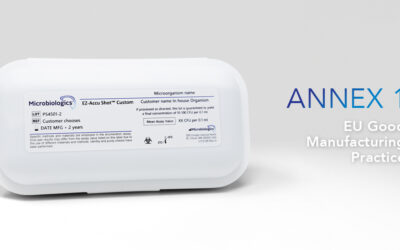To test, or not to test – that is the question.
A frequent reason for recalls of nonsterile products is contamination with Burkholderia cepacia, a microorganism capable of causing serious illness in patients with impaired immune systems or chronic lung disease. Despite the threat of B. cepacia, the strain is not listed as an objectionable microorganism in the United States, European or Japanese Pharmacopeias.
So, what are pharmaceutical laboratories to do? Should all nonsterile pharmaceutical, personal care products and water systems be tested for B. cepacia? Below are three compelling arguments for and against requiring B. cepacia testing that might cause you to question your stance on the issue.
The Microorganism in Question
B. cepacia complex consists of over 17 species. It is an aerobic, motile, Gram-negative rod that is found world-wide in soil, water and plant rhizospheres.
The Debate
The Case for Zero-Tolerance/Requiring Testing
1. A Serious Threat: B. cepacia is a rare but serious threat to cystic fibrosis patients. One-third to one-half of cystic fibrosis patients who become colonized with B. cepacia succumb to Cepacia syndrome, a fatal combination of necrotizing pneumonia, rapid respiratory decline and bacterimia.4
The elderly, the very young, cancer patients and people with chronic illness are also at risk for illness with B. cepacia. The species has been associated with lower respiratory infection, peritonitis, neonatal meningitis and brain abscesses, wound infections, urinary tract infections, and ocular infections.5 Treatment of B. cepacia infections is challenging because it is intrinsically resistant to a wide range of antimicrobial agents.
2. B. cepacia can form Biofilms: B. cepacia can survive for several months in water and remain viable in conditions where few nutrients are available. It is a common microorganism recovered from pharmaceutical water systems, and if it is not controlled, B. cepacia can form biofilms on surfaces of tanks and pipes.
Cells in a biofilm are embedded in a matrix of extracelleular polymeric substances, making them more resistant to chemical sanitizers.7 Because water is widely used during manufacture of pharmaceuticals (e.g. raw material, active pharmaceutical ingredient and cleaning applications), it has the potential to contaminate nonsterile products with B. cepacia.
3. A Frequent Contaminant: Recalled products due to B. cepacia contamination over the past two decades include eyewash, nasal spray, alcohol-free mouthwash, anti-cavity rinse, skin cream, baby and adult wash cloths, surgical prep cloth, electrolyte solutions and radiopaque preparations.1 B. cepacia contaminated these products even in the presence of antimicrobial preservatives.6
Stool softeners and prefilled saline flush syringes were recalled in 2016 due to contamination with B. cepacia. The strain was found in several lots of the stool softener (oral liquid docusate sodium) and in the water system.2 The recall involving the prefilled saline flush syringes was Class 1 – the most serious type of recall.3
According to the U.S. Centers for Disease Control and Prevention (CDC), the effects of B. cepacia on people, “…vary widely, ranging from no symptoms at all to serious respiratory infections, especially in patients with cystic fibrosis.” In some cases, B. cepacia may go undetected during testing because it can be difficult to isolate it from a product or water system. The tests recommended in USP <61> and USP <62> may not be sufficient for isolating it. An enrichment step may be needed.1
The Case for Not Requiring Testing
1. It is everywhere: B. cepacia is ubiquitous. It is found in soil, food and water. People have more exposure to B. cepacia in the environment than they do in pharmaceutical and personal care products.
While it is true that B. cepacia can cause serious illness if it contaminates inhalants and nasal products, this does not mean it can cause illness if small numbers of the organism contaminate water systems or other types of nonsterile products.
2. Current Good Manufacturing Practices (CGMP) will prevent contamination with B. cepacia: If a company follows good manufacturing practices including using strict process design, adhering to daily operational control, validating, qualifying, and monitoring the water purification, storage and distribution system, B. cepacia will not contaminate a nonsterile product.
3. It is responsibility of the individual manufacturer to decide what is objectionable: The USP cannot possibly list all species that can be objectionable given the right circumstances. That is why indicator microorganisms are listed in USP <62>. It is up to the individual manufacturer to perform a risk analysis to determine what species are risks to users of the product.
Now that you’ve read the arguments for and against, do you think B. cepacia testing should be required for all nonsterile pharmaceutical and personal care products? No matter what side of the debate you fall on, there is no question that laboratories have the responsibility to keep consumers safe by testing products at risk for B. cepacia contamination.
Here’s some good news for pharmaceutical and personal care product laboratories – B cepacia is now available in EZ-Accu Shot™ for Growth Promotion Testing! Visit our website to find the QC microorganisms your lab needs in a variety of easy-to-use formats.
References
1Barlasov, J., Sutton, S., Jakober, R. Recovery of Stressed (Acclimated) Burkholderia cepacia Complex Organisms. American Pharmaceutical Review. 2014. http://www.americanpharmaceuticalreview.com/Featured-Articles/160451-Recovery-of-Stressed-Acclimated-Burkholderia-cepacia-Complex-Organisms/
2FDA. FDA Updates on Multistate Outbreak of Burkholderia cepacia Infections. October 2016. https://www.fda.gov/Drugs/DrugSafety/ucm511527.htm
3FDA. Recalls Normal Saline Flush IV Syringes Due to Possible Burkholderia Cepacia Bloodstream Infections https://www.fda.gov/MedicalDevices/Safety/ListofRecalls/ucm535293.htm
4Hauser, N., Orsini, J. Case Report, Cepacia syndrome in a Non-cystic Fibrosis Patient. Case Reports in Infectious Diseases. Volume 2015, Article ID 537627. 2015.
https://www.hindawi.com/journals/criid/2015/537627/
5Pegues, D. Burkholderia cepacia complex. Antimicrobe. http://www.antimicrobe.org/b19.asp
6Torbeck, L., Raccasi, D., Guilfoyle Burkholderia cepacia: This Decision is Overdue. PDA Journal of Pharmaceutical Science and Technology. 2011, 65 535-543. 2011. https://www.fda.gov/downloads/aboutfda/centersoffices/cder/ucm275569.pdf
7USP 39-NF 34. <1231>. Water for Pharmaceutical Purposes. 2017.







did cause nosocomail infection.
thank you for the nice information
Difficult to see why the ubiquitous nature of a potentially harmful organism makes a case for not testing for it. MRSA is fairly ubiquitous in the environment; hospitals found out the hard way testing for it/taking measures to control it are good strategies.